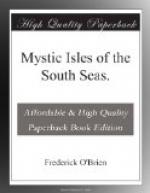Our canoe was twenty feet long, and with a very strong outrigger, but though all four of us paddled, Teta, the chief man of Puforatoai, in the stern, steering, the vaa labored heavily. Tatini was adept in canoeing, and with a quartet of hoe we would have ordinarily sent the vaa spinning through the water; but we were nearing the southernmost extremity of the Presqu’ile, and the wind and current from the northeast swept about the broken coast in a confusion of puffs and blasts, choppy waves and roaring breakers, and made our progress slow and hazardous. The breeze caught up the foam and formed sheets of vapor which whipped our faces and blinded us, while an occasional roller broke on our prow, and soon gave Tatini continuous work in bailing with a handled scoop.
Opposite the pass of Tutataroa our greatest peril came. The ocean swept through this narrow channel like a mill-race. The first swell tossed us up ten feet, and we rode on it fifty before Teta could disengage us from its clasp, and, without capsizing, divert our course westward instead of toward the parlous shore. One such jeopardy succeeded another. We were in a quarter of an hour directly under black and frowning heights from which a score of cascades and rills leaped into the air, their masses of water, carried by the gusts, falling upon us in showers and clouds, aiding the flying scud in shielding the distance ahead from our view.
“Aita e ravea,” shouted Teta to me. “It is impossible to go on.”
We were all as wet as if in the sea, our faces and bodies stung by the spindrift, and we were barely able to glimpse a dark and heaving panorama of surf, rock, and bluff in the mists that now and again were penetrated by the hot sun.
“Maitai! Hohoi!” I replied above the clangor, and raised my paddle.
Carefully and in a wide circle the vaa crept around to head back toward our port, and it was after sunset before we were in Teta’s house in Puforatoai. The villagers met us with torches and incredulous aues and we walked up the road singing the song of the “Ai Dobbebelly Dobbebelly,” which was known wherever a fisher for market dwelt in all Tahiti. The farther from Papeete and more and more as time passed, the words lost resemblance to English, and became mere native sounds without any exact meaning, but with a never-forgotten sentiment of rebellion against government and of gild alliance.
“Give us a hand-out!” had changed from “hizzandow” in Papeete, to “Hitia o te ra!” which meant that the sun was rising. Within a year or two the entire text would doubtless merge into Tahitian with only the martial air of “Revive us again!” and the dimming memory of the fish-strike to recall its origin. I had known a native who, whenever he approached me, sang in a faltering tone, “Feery feery!”
I asked him after many weeks what he meant, and he said that that was a himene, which a young American had sung at his potations in his village in the Marquesas Islands. I had him repeat “Feery feery!” dozens of times, and finally snatched at an old glee which ran through my mind: “Shoo Fly, don’t bother me!” and when I sang it,




